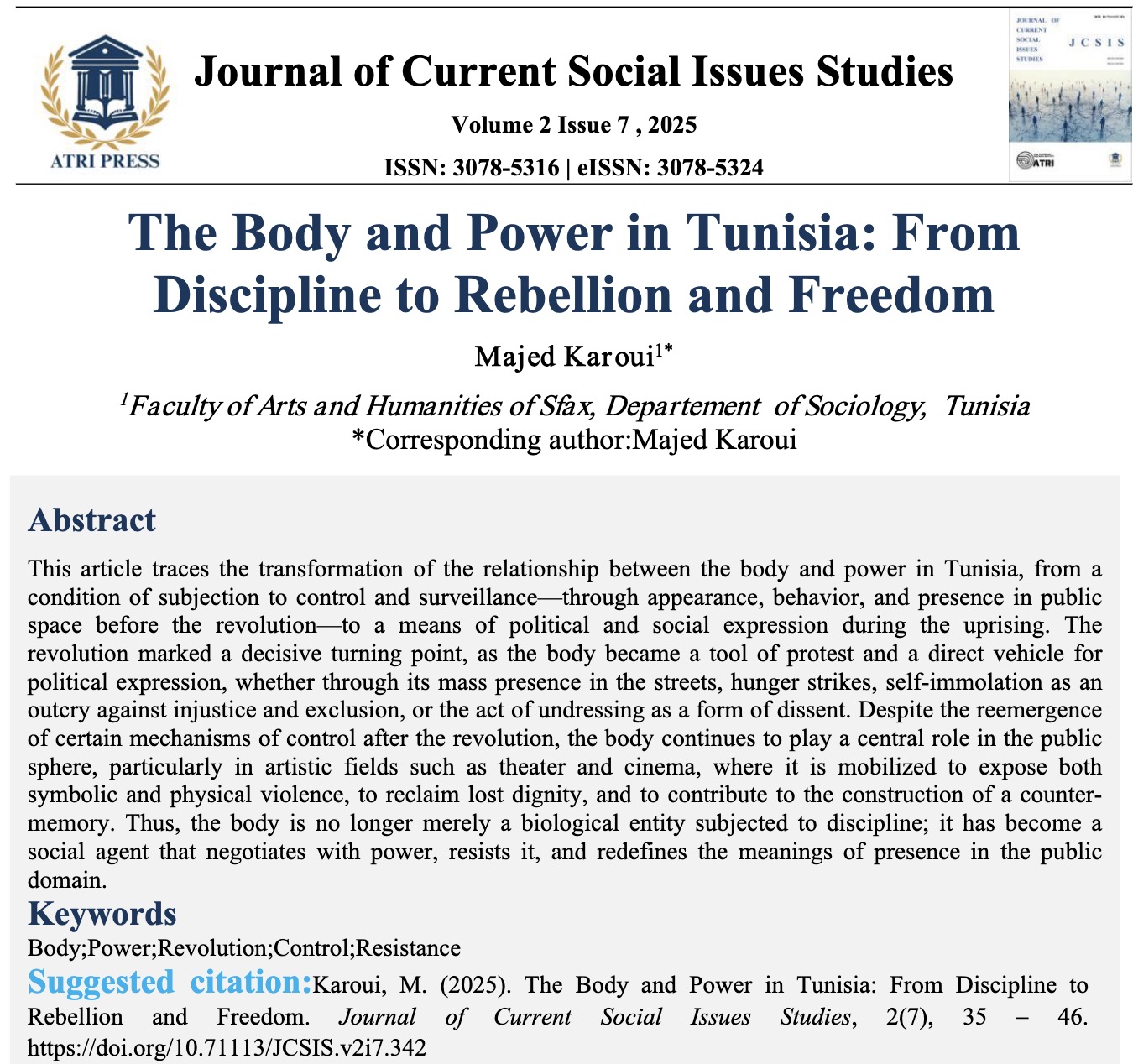The Body and Power in Tunisia: From Discipline to Rebellion and Freedom
DOI:
https://doi.org/10.71113/JCSIS.v2i7.342Keywords:
Body, Power, Revolution, Control, ResistanceAbstract
This article traces the transformation of the relationship between the body and power in Tunisia, from a condition of subjection to control and surveillance—through appearance, behavior, and presence in public space before the revolution—to a means of political and social expression during the uprising. The revolution marked a decisive turning point, as the body became a tool of protest and a direct vehicle for political expression, whether through its mass presence in the streets, hunger strikes, self-immolation as an outcry against injustice and exclusion, or the act of undressing as a form of dissent. Despite the reemergence of certain mechanisms of control after the revolution, the body continues to play a central role in the public sphere, particularly in artistic fields such as theater and cinema, where it is mobilized to expose both symbolic and physical violence, to reclaim lost dignity, and to contribute to the construction of a counter-memory. Thus, the body is no longer merely a biological entity subjected to discipline; it has become a social agent that negotiates with power, resists it, and redefines the meanings of presence in the public domain.
References
Abaza, M. (2014). The dialectics of the visual: The politics of representation in contemporary Egyptian art. American University in Cairo Press.
Ahmed, S. (2004). The cultural politics of emotion. Edinburgh University Press. https://doi.org/10.4324/9780203700372
Arosteguy, K. A. (2013). Rhetorical healing: The reeducation of the body in post-conflict Peru. In M. Gray-Rosendale (Ed.), Rhetoric, recovery, and trauma (pp. 31–46). SUNY Press.
Bahri, O. (2022). The Sociology of the Arab Body [Collective work, in Arabic]. Beirut: Arab Scientific Publishers.
Bayat, A. (2017). Revolution without revolutionaries: Making sense of the Arab Spring. Stanford University Press.
Boal, A. (2000). Theatre of the oppressed. Pluto Press.
Bourdieu, P. (1980). Le sens pratique. Éditions de Minuit.
Bourdieu, P. (1992). Réponses: Pour une anthropologie réflexive. Seuil.
Butler, J. (1990). Gender trouble: Feminism and the subversion of identity. Routledge.
Butler, J. (2004). Undoing gender. Routledge.
Butler, J. (2011). Bodies that matter: On the discursive limits of sex. Routledge.
Butler, J. (2015). Notes toward a performative theory of assembly. Harvard University Press.
DeLaet, D. L. (2013). Gender justice: Transitional justice and the politics of gender. Routledge.
Dumbrovska, R. E. (2024). Bodies, religion, and power in Tunisia: Free Sâlah/Sâlha. Springer Nature.
Foucault, M. (1975). Surveiller et punir: Naissance de la prison. Gallimard.
Foucault, M. (1976). La volonté de savoir. Gallimard.
Giddens, A. (1991). Modernity and self-identity: Self and society in the late modern age. Stanford University Press.
Grami, A. (2018). Women and post-revolution: Gender and power in Tunisia. In E. Lust (Ed.), The Middle East in transition (pp. 93–114). Brookings Institution Press.
Irigaray, L. (1977). Ce sexe qui n’en est pas un. Éditions de Minuit.
Johansson-Nogués, E. (2013). Gendering the Arab Spring? Rights and (in)security of Tunisian, Egyptian and Libyan women. Security Dialogue, 44 (5–6), 393–409. https://doi.org/10.1177/0967010613499784
Khan, S. (2019). Body politics in the Arab Spring: The power of the female body. Palgrave Macmillan.
Khosrokhavar, F. (2012). The new Arab revolutions that shook the world. Paradigm Publishers.
Le Breton, D. (1990). Anthropologie du corps et modernité. Presses Universitaires de France.
Le Breton, D. (2001). La sociologie du corps. Presses Universitaires de France.
Le Breton, D. (2012). L’adieu au corps. Éditions Métailié.
Le Breton, D. (2015). Les passions ordinaires: Anthropologie des émotions. Bayard.
Madlingozi, T. (2007). Good victim, bad victim: Apartheid's beneficiaries, victims and the struggle for social justice. In W. le Roux & K. van Marle (Eds.), Post-apartheid jurisprudence (pp. 137–153). Juta Press.
Martin, C. (2014). Theatre of the real. Palgrave Macmillan.
Nancy, J.-L. (2000). Corpus. Fordham University Press.
Ross, F. C. (2003). Bearing witness: Women and the Truth and Reconciliation Commission in South Africa. Pluto Press.
Scarry, E. (1985). The body in pain: The making and unmaking of the world. Oxford University Press.
Schechner, R. (2006). Performance studies: An introduction (2nd ed.). Routledge.
Springer, S. (2011). Public space as emancipation: Meditations on anarchism, radical democracy, neoliberalism and violence. Antipode, 43(2), 525–562.
Teitel, R. (2000). Transitional justice. Oxford University Press.
Tilly, C. (2004). Social movements, 1768–2004. Paradigm Publishers.
Turner, V. (1969). The ritual process: Structure and anti-structure. Aldine Publishing.

Downloads
Published
How to Cite
Issue
Section
License
Copyright (c) 2025 Majed Karoui

This work is licensed under a Creative Commons Attribution 4.0 International License.























